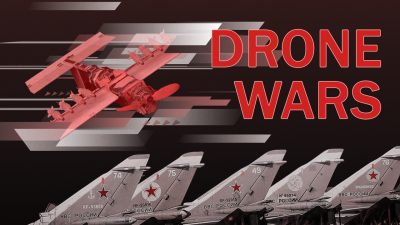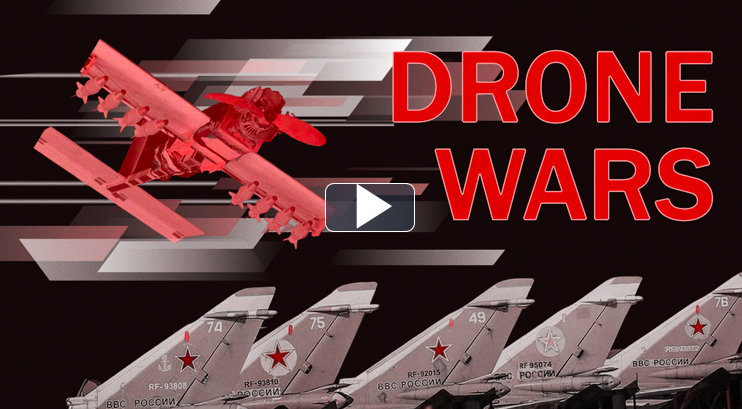Video: Terrorists’ Air Force: Improvised Attack Drones in Syria and Iraq

Over the past years, the usage of improvised armed unmanned aerial vehicles by various armed groups and paramilitary formations has become an inherent part of conflicts in the Middle East.
First reports about the usage of such unmanned aerial vehicles (UAVs) in Syria and Iraq started appearing in the second half of 2016. During the battle for Iraq’s Mosul (October 16, 2016 – July 20, 2017), ISIS was using UAVs and groups of UAVs for disturbing fire along the frontline and attacks on pro-government formations behind the frontline on a regular basis.
Initially, militants employed slightly upgraded commercial drones, like the DJI Phantom, that could be bought via the Internet. These drones cost 500-1,000 USD, have a range of up to 1km and can carry and drop small strike elements like grenades, or IEDs. At the same time, ISIS started developing their own improvised armed UAVs in specially established workshops. However, the terrorist group’s self-proclaimed Caliphate collapsed earlier than it was able to launch a serial production of these weapons. In the end of 2017, the center of UAV production and employment moved to Syria. This time the main party responsible for improvised attack UAV production and employment appeared to be al-Qaeda-linked groups in Greater Idlib. They mostly employ these UAVs in attempts to cause damage to Russian and Syria military infrastructure located behind the frontline. Russia’s Hmeimim Airbase in the province of Lattakia became the main target of these efforts.
On September 27, 2019 the Russian Defense Ministry reported that for the past two years, air defense and electronic warfare systems deployed at Hmeimim Airbase have shot down or disabled 118 unmanned aerial vehicles. 58 of these UAVs have been neutralized since the beginning of the year 2019.
A majority of UAVs have been launched from the southern part of the Idlib de-escalation zone, in particular the towns of al-Lataminah and Khan Sheikhun where workshops for assembling UAVs and UAV launch sites were found. After the liberation of these towns by the Syrian Army in August, the intensity of UAV attacks on the Russian airbase decreased, but has not fully ceased. Furthermore, militant groups continue to modernize their UAVs and UAV employment approaches.
The most recent UAV attacks on Hmeimim Airbase took place on August 11 and September 3. The August attack involved six UAVs: five attack UAVs and a control UAV. The attack UAVs carried striking elements with explosives, while the control UAV was used to direct them toward targets. An armed UAV can carry up to 10 striking elements fastened to its wings.
The September attack involved two UAVs that approached the air base from different directions. One came from the direction of the Mediterranean Sea. According to a Russian military spokesperson, Major-General Igor Konashenkov, the UAV was apparently “launched from a vessel.”
Moscow says that militants are actively modernizing their UAVs. The main priority of these modernization efforts are navigation and control systems. UAV striking elements’ release systems have also been modernized. The technical characteristics of UAVs and employed schemes of their construction demonstrate that militants have begun their serial production.
The Russian side noted that an employment of such equipment requires serious technical training of operators. Major-General Konashenkov said that Russia is concerned that some third party is supplying militants with military technologies related to the UAV production.
UAVs employed by Idlib militants in 2019 are quite different from commercial quadcopters with attached projectiles popular in the previous phases of the conflicts in Syria and Iraq. They are used in swarm formations, when a control UAV is used to direct UAVs equipped with striking elements, and approach targets via complex trajectories maneuvering by means of height and azimuth. Some UAVs are equipped with air pressure measurement units. This indicates that UAVs are capable of transferring and receiving data about their height and coordinates.
The newest UAVs are equipped with two fuel tanks and have the range of 250km and the service ceiling of 4.5km. The previous variant of UAVs had a single fuel tank and the range of 120km. Besides that, militants employ electric-powered UAVs with the range of 50km. UAVs are made of plastics and wood allowing them to have a smaller radar cross-section, thus increasing their chances to avoid detection by air defense systems.
Since the start of the Russian military operation in Syria in 2015, Hayat Tahrir al-Sham and other militant groups have been seeing Russian personnel, equipment and aircraft deployed in the war-torn country as high-priority targets. Militants have repeatedly attacked Hmeimim Airbase with rockets and UAVs. Most of them have been successfully repelled by air defense systems deployed there.
The most successful, and therefore widely known attack on Hmeimim, took place on December 31, 2017. According to an initial version of the event appeared on January 3, 2018 in Russian media, a combined mortar and UAV attack destroyed four Su-24 attack aircraft, two Su-35S multi-role fighters and an An-72 transport aircraft and may have killed or injured 9 servicemen. On January 4, 2018, the Russian Defense Ministry commented on the incident denouncing reports about any equipment damage, but confirming a mortar attack and the death of two personnel. According to the Defense Ministry, “a mobile militant subversive group” was behind the attack. Nonetheless, photo evidence appeared online indicates that at least one aircraft, the Su-24 attack aircraft with the tail number ‘29’, was damaged. No aircraft were destroyed. The incident likely took place because of negligence on the part of some units of Syrian and Russian security forces assigned to secure the perimeter of the base. Just a few days later, air defenses deployed at Hmeimim Airbase and the Tartus naval facility repelled a large-scale UAV attack intercepting 13 armed UAVs.
In response to a constant threat of UAV and rocket attacks, the Russian military boosted active and passive protection measures needed to protect its air group. The perimeter security was strengthened and permanent aircraft hangars were constructed. The air defense regiment was reinforced.
In the coming years, the layered air defense consisting of long-range and short-range complexes and electronic warfare systems had demonstrated their effectiveness. The core of the air defense is the S-400 long-range air defense system, the TorM2 anti-aircraft missile system and the Pantsir-S1 short-to-medium range surface-to-air missile/gun system. The Russian military says that the established air defense allows it to strike all types of aerial targets at a range of up to 250 km.
The Pantsir-S1 appeared to be extremely capable of striking small-size UAVs and fast-speed shells of factory-produced and improvised multiple launch rocket systems employed by militants. An additional protection against UAV attacks is provided by EW systems like the Krasukha.
The Syrian conflict demonstrated that even limited military UAV technologies in the hands of illegal armed groups pose a serious threat that cannot be addressed without the employment of complex active and passive security measures.
The further proliferation of these technologies became almost inevitable after some ‘third party’ had supplied Idlib militant groups with them. Chances that such UAVs could be used against civilian targets somewhere around the world have been growing.
*
Note to readers: please click the share buttons above or below. Forward this article to your email lists. Crosspost on your blog site, internet forums. etc.
We call upon Global Research readers to support South Front in its endeavors.
If you’re able, and if you like our content and approach, please support the project. Our work wouldn’t be possible without your help: PayPal: [email protected] or via: http://southfront.org/donate/ or via: https://www.patreon.com/southfront


